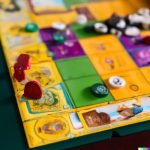Root is a popular board game that offers players a unique asymmetric gameplay experience. Each faction in the game has its own strengths, weaknesses, and play style, creating a dynamic and strategic gaming environment. In this article, we will explore the different root board game strategies to help you understand the intricacies of each faction and how to effectively navigate the game.
The key to mastering Root board game lies in understanding the faction asymmetry, as each faction requires a different approach and strategy for success. Whether you are playing as the Marquise de Cat, Eyrie Dynasties, Woodland Alliance, or Vagabond, it is essential to adapt your gameplay to your faction’s unique abilities and objectives. By learning the specific nuances of each faction, you can develop a winning strategy that maximizes your chances of victory.
In the upcoming sections, we will delve into detailed strategies for each faction in Root board game. From the economic powerhouse of the Marquise de Cat to the dynamic and unpredictable nature of the Vagabond, we will provide insights on how to effectively utilize each faction’s strengths while mitigating their weaknesses.
Additionally, we will explore advanced techniques and tactics for mastering the game, tips for balancing offense and defense, and adapting to different play styles to give you a comprehensive understanding of Root board game strategies.
Understanding the Faction Asymmetry
Root board game is known for its faction asymmetry, where each player controls a unique faction with its own set of abilities, goals, and playstyle. Understanding this faction asymmetry is crucial to developing successful strategies in the game.
Learning the Abilities and Goals
Each faction in Root has different abilities and goals, which greatly impact how they should be played. For example, the Marquise de Cat focuses on building and controlling clearings, while the Woodland Alliance relies on spreading sympathy and inciting revolts. Understanding these distinct abilities and goals is key to formulating effective strategies for each faction.
Adapting to Playstyles
The faction asymmetry in Root also means that each player will have a different playstyle depending on their chosen faction. This requires players to adapt their strategies based on the factions present in the game. For example, playing against a strong Marquise de Cat may require a more defensive strategy, while facing off against an aggressive Eyrie Dynasties may call for a more offensive approach.
Utilizing Faction Interactions
Another important aspect of understanding faction asymmetry is recognizing how different factions interact with each other. Some factions may have natural alliances or rivalries based on their abilities and goals. Players can leverage these interactions to form alliances or disrupt opponents’ plans. By understanding the various dynamics between factions, players can develop more nuanced and effective strategies.
Overall, grasping the faction asymmetry in Root board game is essential for developing successful strategies. Each faction offers a unique experience and presents players with different challenges and opportunities. By learning to adapt to different playstyles, leveraging faction interactions, and understanding each factions’ abilities and goals, players can enhance their gameplay experience and improve their chances of victory using different root board game strategies.
Strategy for the Marquise De Cat
In the game of Root, the Marquise de Cat is a faction that focuses on building and maintaining an efficient economy. Their primary goal is to construct sawmills and workshops, while also expanding their dominance across the board through clearings and buildings. In order to effectively play as the Marquise de Cat, it is important to understand their unique strengths and weaknesses.
Here are some key strategies to consider when playing as the Marquise de Cat:
- Focus on building sawmills and workshops early in the game to generate resources.
- Expand your presence across different clearings in order to maximize control and dominance.
- Utilize crafting opportunities to gain additional advantages on the board.
It is important for players utilizing different root board game strategies to remember that although the Marquise de Cat excels at building a strong foundation, they can be vulnerable if not properly defended. Balancing offense and defense is crucial in maintaining their dominance on the board.
Adapting to different play styles is also essential when playing as the Marquise de Cat, as each game will present unique challenges based on the actions of other factions. By being flexible and observant, players can adjust their strategy accordingly and increase their chances of success.
Strategy for the Eyrie Dynasties
When playing the Eyrie Dynasties faction in the Root board game, it’s important to understand their unique gameplay mechanics and how to effectively strategize to win the game. The Eyrie Dynasties are a highly regimented and hierarchical faction, with players needing to carefully manage their leaders and followers in order to maintain control of the game board. Here are some key strategies for playing as the Eyrie Dynasties:
1. Establish a Strong Foundation: As the Eyrie Dynasties, it’s crucial to start the game by establishing a strong foundation of roosts on the board. This will allow you to expand your influence and control over different clearings, giving you a strategic advantage throughout the game.
2. Manage Decree Cards Wisely: The Eyrie Dynasties’ gameplay revolves around managing their Decree cards, which dictate their future actions and movements on the board. It’s important to plan ahead and carefully consider which actions to include in your Decree each turn, as well as making sure not to fall into turmoil by failing to complete an action.
3. Balance Expansion and Control: Finding a balance between expansion and control is key when playing as the Eyrie Dynasties. It’s important to expand your presence on the board while also maintaining control over your territories and keeping an eye on potential threats from other factions.
By utilizing these strategies for the Eyrie Dynasties, players can maximize their chances of success in the Root board game. However, it’s also important to remain flexible and adapt to different play styles from opponents in order to achieve victory using this faction’s unique abilities. Whether focusing on expanding roosts or carefully managing Decree cards, mastering these different root board game strategies is essential for mastering gameplay with the Eyrie Dynasties faction.
Strategy for the Woodland Alliance
The Woodland Alliance is a unique faction in the Root board game, known for its ability to incite rebellion and gain control through spreading sympathy among the battling creatures of the forest. Playing as the Woodland Alliance requires a different approach compared to other factions, as you rely on building support and gathering sympathy rather than outright conquering territories.
One key strategy for the Woodland Alliance is to focus on spreading sympathy in areas that are not heavily controlled by other players. Look for spaces with few enemy troops or clearings without strongholds, as these are prime locations to place sympathetic tokens and gain control without facing heavy opposition. Additionally, prioritizing building bases and supporters in these areas can help you slowly build up power without attracting too much attention from rival players.
Another effective strategy for the Woodland Alliance involves carefully timing your uprisings and revolts. Instead of launching an uprising at every opportunity, it is often more advantageous to bide your time and wait for the perfect moment when your forces are strong enough to make a significant impact. By being patient and strategic with your revolt actions, you can maximize their effectiveness and catch your opponents off guard.
Additionally, it is important for players of the Woodland Alliance to adapt their strategies based on the actions of other players. Since this faction relies on spreading sympathy across different clearings in order to gain control, you should pay close attention to how your opponents move throughout the game board. Adjust your tactics accordingly to capitalize on their movements and take advantage of any openings they may leave behind.
Overall, playing as the Woodland Alliance requires patience, careful planning, and a keen awareness of the ever-changing dynamics of the game board. By utilizing these different root board game strategies effectively, players can maximize their chances of success while embodying the spirit of rebellion within the forest.
Strategy for the Vagabond
The Vagabond is a unique faction in the Root board game, offering players a more solitary and opportunistic playstyle. Unlike the other factions, the Vagabond operates on its own, forging alliances and rivalries as it sees fit. Mastering the strategy for the Vagabond requires a deep understanding of its mechanics and the ability to adapt to varied situations.
One key aspect of playing as the Vagabond is utilizing its versatility. The Vagabond has the ability to move freely through the forest, interacting with other factions, so players should take advantage of this unique trait.
This can allow them to complete quests, aid or sabotage other factions, and ultimately earn victory points in unconventional ways. By keeping an open mind and being ready to switch tactics at a moment’s notice, players can effectively navigate the ever-changing landscape of the game.
Another important element of playing as the Vagabond is understanding when to be diplomatic and when to be assertive. The faction’s success heavily relies on forming temporary alliances while also pursuing their own objectives. Finding a balance between cooperation and competition is crucial in order to thrive as the Vagabond. It’s important for players to remain adaptable and not be afraid to take risks if it means gaining an advantage.
Varying approaches can lead to success when playing as different Root board game strategies with friends who use various tactics themselves. It demands strategic thinking that takes into account both immediate needs and long-term goals while navigating complex interactions with other factions on the board. By mastering these methods, players will be well-equipped to undertake victories even in unpredictable circumstances.
| Root Board Game Strategy Tips | Vagabond Strategy Tips |
|---|---|
| Utilize versatility | Understand when to be diplomatic or assertive |
| Be adaptable | Balance cooperation and competition |
| Consider long-term goals | Vary approaches based on opponents’ tactics |
Advanced Techniques and Tactics
In the game of Root, there are multiple factions each with different abilities and goals. As a result, players must use different root board game strategies to succeed with each faction.
One advanced technique that applies to all factions is understanding the ebb and flow of power throughout the game. In Root, factions will rise and fall in strength as the game progresses. Knowing when to strike or when to lay low can be crucial for success. This involves paying close attention to the current state of the game, including which factions are struggling or flourishing.
Another important tactic is adaptability. Since each faction has its own unique abilities, it’s essential to be adaptable in your strategy depending on which faction you are playing as or facing against. For instance, if you are playing as the Vagabond, focusing on completing quests might be your primary goal. However, if you are facing off against the Woodland Alliance, preventing them from spreading sympathy across the board could be a more urgent priority.
Ultimately, mastering advanced techniques and tactics in Root requires a deep understanding of not only your chosen faction but also those of your opponents. Players must be able to adapt their strategies on-the-fly based on ever-changing conditions within the game. This level of adaptability and strategic thinking is what sets expert Root players apart from beginners.
| Root Board Game Strategy | Description |
|---|---|
| Understanding Power Dynamics | Knowing when to strike or lay low based on power dynamics is essential. |
| Adaptability | Being adaptable to different faction abilities and opponents’ strategies is crucial for success. |
| Deep Understanding | Mastery of advanced techniques requires a deep understanding of both player-faction dynamics. |
Tips for Balancing Offense and Defense
When playing the Root board game, it is essential to find a balance between offense and defense in order to succeed. Balancing offense and defense can be a challenging task, as different factions have varying strengths and weaknesses that need to be considered. In this section, we will explore some tips for effectively balancing offense and defense regardless of the faction you are playing.
Understand Your Faction’s Strengths and Weaknesses
One of the first steps in balancing offense and defense is to understand the strengths and weaknesses of your chosen faction. Each faction in Root has its own unique abilities and play style, which will influence how you approach both offensive and defensive strategies. Take the time to study your faction’s capabilities and consider how they can be used to your advantage in different situations.
Assess the Current Game State
Balancing offense and defense also requires assessing the current game state and adjusting your strategy accordingly. If you notice that other players are focusing heavily on offensive actions, it may be wise to prioritize defensive moves to protect your territories or stronghold. On the other hand, if an opportunity presents itself for a successful offensive maneuver, it may be worth taking a calculated risk to gain an advantage.
Be Flexible in Your Approach
Finally, being flexible in your approach is key to finding the right balance between offense and defense. Different situations may call for different tactics, so it’s important to adapt as the game progresses. This may involve shifting focus between offense and defense based on changing circumstances or even teaming up with other players to create strategic alliances. By remaining adaptable and open-minded, you can increase your chances of success regardless of which faction you are playing.
Adapting to Different Play Styles
Root Board Game offers an immersive experience with its faction asymmetry, allowing players to explore various strategies and play styles. Adapting to different play styles is essential for mastering the game and achieving victory, as each faction requires a unique approach for success.
One way to adapt to different play styles in Root is by understanding the strengths and weaknesses of each faction. The Marquise de Cat excels in dominance through its strong military presence, while the Eyrie Dynasties rely on building a decree to maintain power. The Woodland Alliance thrives on spreading sympathy and inciting revolts, and the Vagabond gains strength through building relationships with other players. By comprehending these differences, players can tailor their strategies accordingly.
Another important aspect of adapting to different play styles in Root is being flexible and open-minded during gameplay. It’s crucial to be aware of the dynamic nature of the game and adjust your tactics based on the actions of other players. This adaptability can lead to unexpected alliances, strategic maneuvers, and outmaneuvering opponents who may have anticipated your moves.
Ultimately, adapting to different play styles in Root Board Game requires a deep understanding of each faction’s unique abilities and an ability to think on your feet during gameplay. By embracing versatility and being willing to shift strategies as needed, players can maximize their chances of success regardless of which faction they are playing.
Whether it’s dominating with the Marquise de Cat or forging alliances as the Vagabond, adapting to different play styles is a key component of mastering Root Board Game.
Conclusion and Final Thoughts
In conclusion, the Root board game offers a rich and dynamic gaming experience with its faction asymmetry and diverse strategies. Each faction presents different root board game strategies that players can explore and master to achieve victory. From the Marquise de Cat’s focus on area control to the Woodland Alliance’s guerrilla warfare tactics, understanding and leveraging each faction’s unique abilities is key to success in the game.
As players delve deeper into the advanced techniques and tactics of Root, they will learn how to effectively balance offense and defense, adapting their play style to the ever-changing dynamics of the game. This flexibility is essential for staying competitive and responding to the actions of other players. Additionally, learning how to adapt to different play styles, whether aggressive or defensive, will enable players to anticipate their opponents’ moves and stay ahead in the game.
Ultimately, mastering different root board game strategies requires practice, patience, and a willingness to continuously learn from each gaming experience. By embracing the complexities of each faction and honing their skills in adapting to various play styles, players can fully immerse themselves in the strategic depth that Root has to offer.
Whether they choose to conquer territories as the Marquise de Cat or lead a rebellion as the Woodland Alliance, Root provides an exhilarating challenge for tabletop gamers seeking diverse and engaging gameplay.
Frequently Asked Questions
How Do You Win at Root?
Winning at Root requires understanding the unique abilities and asymmetrical gameplay of each faction. It’s important to adapt your strategy based on the faction you’re playing, as well as the actions of your opponents.
Is Root a Strategy Game?
Yes, Root is definitely a strategy game. It involves deep tactical decision-making, asymmetric player powers, and a focus on area control and resource management. Players must carefully plan their moves to outmaneuver their opponents.
What Is Advanced Setup in Root?
In Root, advanced setup refers to customizing the game by choosing specific factions, map layouts, and other options to tailor the experience to your group’s preferences. This adds variety and replay value to the game, allowing for different strategies and interactions with each playthrough.

I love playing all kinds of games – from classics like Monopoly to modern favourites like Ticket to Ride.
I created this blog as a way to share my love of board games with others, and provide information on the latest releases and news in the industry.





